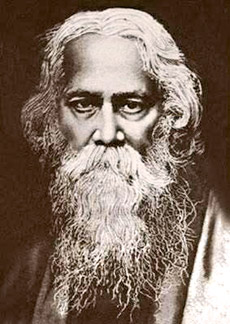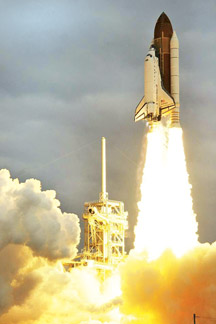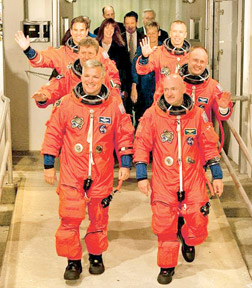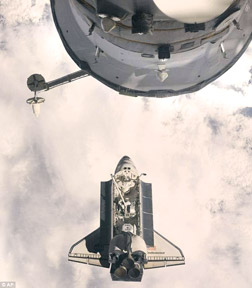|
MAGAZINE
Tagore: a visionary educationist
Yasasiri Janaka Kumara
Continued from yesterday:
He was emphatic that it has endangered a feeling of social ostracism
amongst the vernacular educated majority, which leads to exploitation of
one class by another and glorification of social inequality, which may
end up in an upheaval.
After having tried his hand at rural re-construction as a remedy and
imparting knowledge to villagers through a reading room and conducting
lectures for the youth he undertook in 1932, what perhaps could be
termed as the most important journey in the cultural landscape of
Colonial Ceylon, to India at the age of 27 years to visit Gurudev Tagore
at Santiniketan, to study the Poet's lesser known work as an educator
and a rural reformer. He was impressed with Gurudev's advice 'Let us
never have the power of spirit to say that for the village people very
little is enough'. This and what weighed heavily in his mind explain
what was to become his mission in life "Would he come and help us to
escape from the artificiality of Western Culture and lifestyles that has
engulfed our lives?" as he urged Ceylonese to do ten years ago.
|

Rabindranath Tagore |
Child's environment
But what exactly made Wilmot Perera invite Gurudev Tagore to visit
Ceylon and to lay the foundation stone for Sri Palee 77 years ago? He
had explained it in 1944.
"It is true that all children are lovable, but the children in the
villages are beautiful, genuine and sincere. Perhaps they have not been
influenced by the competition and artificial living conditions of the
city. But what a vast gap exists between the students of a village
school and their counterparts in a Colombo school. It is heart-rendering
to see how education which should harness good qualities and innate
talents of every child is being given to them at village schools. It
should be more in harmony with child's environment.
The doors of English academic institutions do not open for them, even
though they are qualified to make use of them. They are only for the
children from affluent classes. A start had to be made to change this
educational system based on artificiality and inequality. It is the
reason for the founding of Sri Palee inspired by Rabindranath Tagore."
He made music, dancing and crafts important sections of Sri Palee's
curriculum.
He faced many adversaries for teaching dancing to girls and for
following India. But he was convinced that in fulfilling his ideals of a
renaissance in culture, aesthetic studies should occupy an important
part in a child's education, both boys and girls. For he said "Every
child cannot become a fully fledged musician or a dancer. But every
child can be provided with the opportunity of imbibing the beauty of
dance and music and learning to appreciate good music and good dancing.
This too should become a part and parcel of a child's education. Unless
one learns to choose the good from the bad, he is not a learned man.
This fact is not limited to music, dancing and art alone. The ultimate
goal of education is training the mind and intellect to choose the right
from the wrong, the good from the bad in every thought or deed."
He was conscious then, that three Indians _ The Buddha, Arahat
Mahinda and Theri Sangamiththa have been responsible for the spiritual,
intellectual, cultural and vocational enlightenment of Sri Lankans.
Hence he felt that it is to India that he should go for inspiration.
Thus, the fourth Indian to enlighten us became Gurudev Tagore. So, began
the cultural renaissance witnessed in the mid 1930s. This is how an
editorialist in the 'Ceylon Daily News' had recorded it in 1934. "Once
upon a time when the moon was very young, there came by chance to this
country a Bengali called Vijaya to conquer the primitive tribe that
inhabited this island in the days of pre-history. After the lapse of
about 25 centuries another Bengali has come, not by chance, with another
band of loyal followers for the cultural conquest of what by contrast
may be considered the primitive Ceylonese in the way of the highest
possessions of Man Art and Beauty and Music."
Education reforms
Now there is a clamour for reforms in education, because, we have
around 130,000 who fail ordinary level annually. 63% failures in the
subject of English at the same level. Around 100,000 who fail advanced
level and another 100,000 who qualify to enter university but there is
no room for them. So, is history being repeated in the field of
education, 79 years after Wilmot Perera made his startling and prophetic
observations; after the democratization of education by Dr. C.W.W.
Kannangara and 50 years after the take over of schools by the State?
Suffice it to say that the upheavals by the 'unvocal class', two in the
South and one in the North remind us about the grim reality of what he
has foreseen and failures of the past. Recently a newspaper editorialist
had this to say on "What ails our schools?"
"What ails our education system is that it hardly prepares the child
for meeting challenges in life. Children are taught in pre-school where
they are supposed to play but not in school, where they are supposed to
learn. Most schools have out-sourced education to the private sector.
Teachers no longer play the role of counsellors. Nor are there
professional counsellors available in schools to help children who are
wary of confiding their problems to their parents. Some teachers scare
them out of their wits when they happen to do something wrong and even
drive them to suicide.
Education Minister Bandula Gunawardane is spearheading a movement for
education reforms. Education, no doubt, needs reforms but let it be
reformed in such a way that children will be free from torture and have
enough time for themselves to enjoy their childhood fully and grow up as
healthy men and women devoid of frustration."
It is in this scenario that Tagore's views on education would be of
immense value. They inspired Wilmot Perera to do what he did at Sri
Palee and his views on socio-economic and cultural issues and education
as they are of immense value and relevance even today.
Both were conscious that education should first and foremost ensure a
happy childhood and equal opportunities for every child of the land and
produce integrated personalities useful to the society, with an
aesthetic sense to appreciate nature, art, music and dancing.
As we celebrate the 150th Birth Anniversary of the Gurudev it would
be fitting to quote his faithful Sri Lankan disciple Wilmot A. Perera to
conclude this article as he has paid the finest tribute to Tagore for
the cultural renaissance in Sri Lanka in the 20th Century, four years
later in 1938.
Everything that forms the culture of Ceylon has been derived from
India. Didn't Vijaya himself come from India and more particularly from
Bengal? And what of Mahinda and his gift of Buddhism? And in the more
recent past, can it be denied that the awakening in our country to the
necessity of developing the Fine Arts is due to Rabindranath Tagore and
his students from Santiniketan? It was left to him to re-discover for us
the beauty of the Kandyan Dance, which incidentally, is considered to
have been brought to us from Malabar.
We are proud to claim that our institute christened by him on his
visit four years ago, has contributed in no small measure to promote
that cultural awakening. This is solely due to the love which the Poet
and his workers have cherished for us.
There can be only one Rabindranath Tagore, only one Santiniketan. His
disciples are mere whispers of the great song. But yet we in Ceylon owe
to him and to India that produced him a debt we cannot repay."
Concluded
End of a space era
Endeavour blasts off for final mission:
Chamari SENANAYAKE
One of the greatest creations of mankind, the most-traveled space
shuttle, Discovery, brought its remarkable 27-year career to an end on
March landing 9 at the
Kennedy Space Center in Florida. Now its sister ship Endeavour has
launched for the final time last Monday morning to a cheering crowd of
more than 500,000 people on the ground and billions that watched on TV
and online all over the world, soon ending her career to become the
second last flight of NASA’s Space Shuttle programme.
|

The breath-taking launch of Endeavour was watched by billions
around the world. AP |
The 134th flight in the NASA Space Shuttle program is of Endeavour,
and it is also the one before the last. In 1986, Space shuttle
Challenger was destroyed in an accident while the whole world watched in
horror and Endeavour was built as Challenger’s replacement. It is named
after the British HMS Endeavour, the ship, which took Captain James Cook
on his first voyage of discovery (1768-1771). Therefore, the name is
spelled in British English manner, rather than the American English.
Endeavour was named through a national competition involving students in
elementary and secondary schools and Endeavour was the most popular
entry. Endeavour was delivered by Rockwell International Space
Transportation Systems Division in May 1991 and first launched a year
later, in May 1992. On its first mission, it captured and redeployed a
stranded (lost in space) satellite called INTELSAT VI, a communications
satellite.
The first African-American woman astronaut, Mae Jemison, was brought
into space on the mission in September 12, 1992. In 1993, it made the
first service mission to the Hubble Space Telescope.
In January 1998 it made a rendezvous with Russian Mir space station
and did an astronaut exchange. Including its final mission, it has
completed an impressive 25 Space missions.
Endeavour’s commander US Navy Captain Mark Kelly urged America to
continue to ‘reach for the stars’ as he led the orbiter on its 25th and
final journey into space from Kennedy Space Centre at Cape Canaveral,
Florida. People on the ground cried and cheered ‘go Endeavour’ as it
roared into the sky above a giant ball of flame before disappearing into
clouds. Endeavour, which is the youngest shuttle in the fleet, was due
to launch on April 29th but a heater problem in one of the shuttle’s
hydraulic power generators failed, forcing it to be cancelled.
Shuttle launch director Mike Leinbach said: ‘She’s got a lot of life
left in her, but that’s not meant to be.’
The Space Shuttle’s commander Mark Kelly, suffered a personal tragedy
when his wife, US congresswoman Gabrielle Giffords was shot in the head
when a gunman put a bullet through her brain during a public event in
Tucson. Six people were killed, and she was in critical state at first
but now recovering. And the commander had to continue his mission
training while caring for his wife. He paid tribute to the thousands of
shuttle workers who made the launch possible and urged that the end of
the shuttle programme in July, when Atlantis- the other sister to
Discovery and Endeavour is due to fly the final mission, should not hold
America back from its dreams.
This is also not a routine mission for the youngest Shuttle in the US
Orbiter programme. Endeavour is carrying her most expensive payload ever
- a $2billion particle physics experiment known as the Alpha Magnetic
Spectrometer (AMS) designed to probe the unknown reaches of space and
help us understand the secrets of the universe.
|

Commander Mark Kelly (left) leading his five American and one
Italian Astronaut crew to the launch of Endeavour. EPA |
|

’Meeting you for the last time’ Endeavour prepares to dock on
the Harmony node of the International Space Station. AP |
Endeavour and its experienced crew of five Americans and an Italian
were headed for the International Space Station.
On Wednesday, they successfully docked at the International Space
Station (ISS). Before attaching itself to the International Space
station, the ISS commander and Endeavour commander exchanged messages
saying they can’t wait to see each other.
Once Endeavour’s cargo is installed on the station, the crew will
turn its attention to four planned space walks and maintenance chores.
The shuttle is due back at Kennedy Space Center on June 1.
Only the launch of Space Shuttle ‘Atlantis’ as NASA’s 135th and final
shuttle mission, scheduled for mid-July, remains before America finds
itself unable to send its own astronauts into space on its own vehicles.
Once Atlantis’s mission is complete, the nation will depend on flights
of Russian rockets to deliver astronauts to and from the International
Space Station.
The program is being closed due to high operating costs and so funds
can be freed-up to develop new spacecraft that can travel beyond the
station’s 220-mile-high orbit.
More than twenty organizations have submitted proposals asking NASA
for Endeavour to be displayed in their institutions after the
retirement. After much anticipation, it was announced that Endeavour
would be given to the California Science Centre in Los Angeles. It will
be a fitting place for an angel that conquered the space for mankind to
spend her retirement. |



